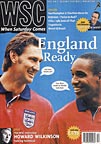 UEFA seem intent on changing the transfer system. Guy Osborn & Steve Greenfield explain how this could affect England and beyond
UEFA seem intent on changing the transfer system. Guy Osborn & Steve Greenfield explain how this could affect England and beyond
It seems barely a week goes past these days without a new proposal to regulate the international movement of players. The most recent have involved reintroducing restrictions on foreigners, standardising transfer windows across Europe and effectively abolishing the transfer system. Yet again, it appears that poor old Jean-Marc Bosman is the root cause of most of these ideas.
Dino Zoff, the Italian national coach, was among the recent critics, bemoaning the fact that the number of foreign players in Serie A was limiting selection for the national side. He suggested new restrictions on foreigners (perhaps five per team) could be introduced in the national leagues. Such a policy would require a major change of approach by the European Union, given that the previous pre-Bosman restriction was held to contravene the rights on free movement within the community. Football would require an exemption to give effect to any restriction. Unless there is a considerable change of heart on behalf of the EU, this proposal does not seem likely to get further than the minds of frustrated coaches.
The next bright idea came from UEFA themselves, who decided they wanted to bring in common transfer windows for European leagues from season 2000-2001. This would limit the periods when players could be transferred to the close season and a few weeks after Christmas. This would clearly be a radical departure for English clubs and both the Football League and the Premier League indicated that such proposals had always been rejected by the clubs in the past. One can also imagine the dismay of sports editors, faced with losing their pages of transfer gossip for large parts of the year.
However, these stories were small beer compared to the results of FIFA’s most recent brainstorming session. The world governing body is reportedly set to remove the current transfer system next year and replace it with a new scheme in which the fee for a player would be set by a formula based upon his wages and the number of years left on his contract. The amount would be determined by multiplying the yearly wage by the years left on the contract – producing a figure that would be vastly lower than the fees that have become commonplace in recent years.
David Dein would have been even less enamoured with Nicolas Anelka if Arsenal had received around £2 million for the striker from Real Madrid, rather than a sum more than ten times that. Yet that is roughly what the compensation would have been if this new scheme had been in force. The idea of compensation for the clubs, rather than a fee for transfer of registration, has appeared periodically. Some national associations have used such a mechanical calculation, based on service and salary, to set transfer fees. Indeed, Anelka’s associates argued during his transfer saga that under European law all Arsenal were entitled to was a compensation figure.
While the spectre of Bosman has left many clubs in the position of having to sell players before their contract is up in order to realise some capital in their asset, this new approach would vastly limit even that possibility. For example, rumours before the start of the season suggested that Manchester United would seek to sell Roy Keane before his contract expires in June 2000 for a fee in excess of £10 million.
However, under the FIFA proposals the amount paid would have been “merely” one year’s wages – an estimated £1 million. Similarly, Sol Campbell, perhaps the most coveted English player of recent years, has a contract at Tottenham that expires in June 2001. While is worth under the current system has been estimated at somewhere near £20 million, the FIFA approach would mean his sale would realise less than a tenth of that sum. And, of course, the figure would decrease constantly as his contract neared its end.
The fact that FIFA and UEFA have offered their thoughts on these subjects does not mean, of course, that what they have proposed will automatically happen. It is the big clubs and the most sought-after players who are likely to play the key roles in determining the future shape of the transfer market.
From WSC 154 December 1999. What was happening this month